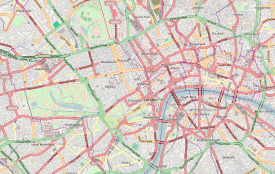St James’s Palace
| St James's Palace | |
|---|---|

Main entrance of St James's Palace in Pall Mall
|
|
| Location |
London, SW1 United Kingdom |
| Coordinates | 51°30′17″N 00°08′15″W / 51.50472°N 0.13750°WCoordinates: 51°30′17″N 00°08′15″W / 51.50472°N 0.13750°W |
| Built | 1531-1536 |
| Architectural style(s) | Tudor |
St James's Palace is the most senior royal palace in the United Kingdom. Located in the City of Westminster, although no longer the principal residence of the monarch, it is the ceremonial meeting place of the Accession Council and the London residence of several members of the royal family.
Built by King Henry VIII on the site of a leper hospital dedicated to Saint James the Less, the palace was secondary in importance to the Palace of Whitehall for most Tudor and Stuart monarchs. The palace increased in importance during the reigns of the early Georgian monarchy, but was displaced by Buckingham Palace in the late-18th and early-19th centuries. After decades of being used increasingly for only formal occasions, the move was formalised by Queen Victoria in 1837. Today the palace houses a number of official offices, societies and collections and all ambassadors and high commissioners to the United Kingdom are still accredited to the Court of St James's.
Mainly built between 1531 and 1536 in red-brick, the palace's architecture is primarily Tudor in style. A fire in 1809 destroyed parts of the structure, including the monarch's private apartments, which were never replaced. Some 17th-century interiors survive, but most were remodelled in the 19th century.
The palace was commissioned by Henry VIII, on the site of a former leper hospital dedicated to Saint James the Less. The new palace, secondary in the king's interest to Henry's Whitehall Palace, was constructed between 1531 and 1536 as a smaller residence to escape formal court life. Much smaller than the nearby Whitehall, St James's was arranged around a number of courtyards, including the Colour Court, the Ambassador's Court and the Friary Court. The most recognisable feature is the north gatehouse; constructed with four storeys, the gatehouse has two crenellated flanking octagonal towers at its corners and a central clock dominating the uppermost floor and gable; the clock is a later addition, and dates from 1731. It is decorated with the initials H.A. for Henry and his second wife, Anne Boleyn. Henry constructed the palace in red brick, with detail picked out in darker brick.
...
Wikipedia

